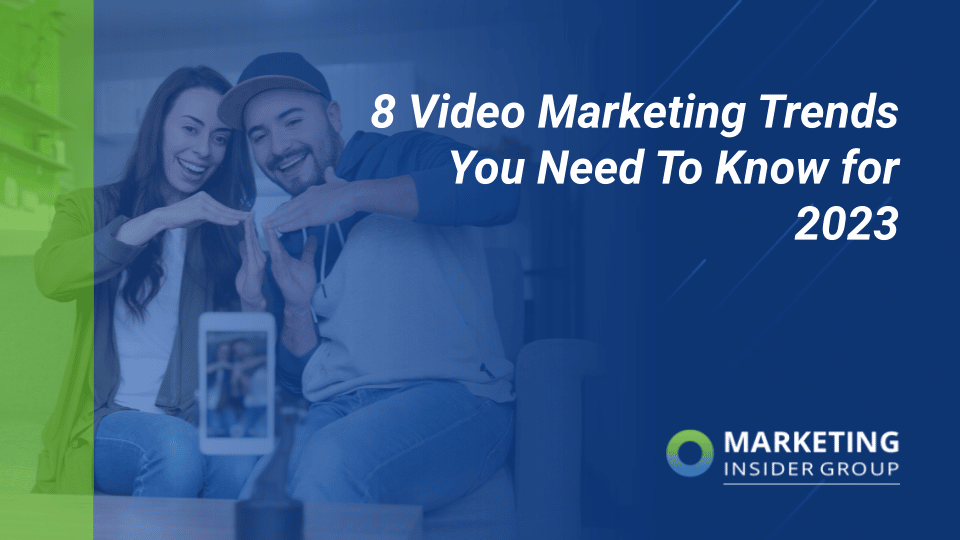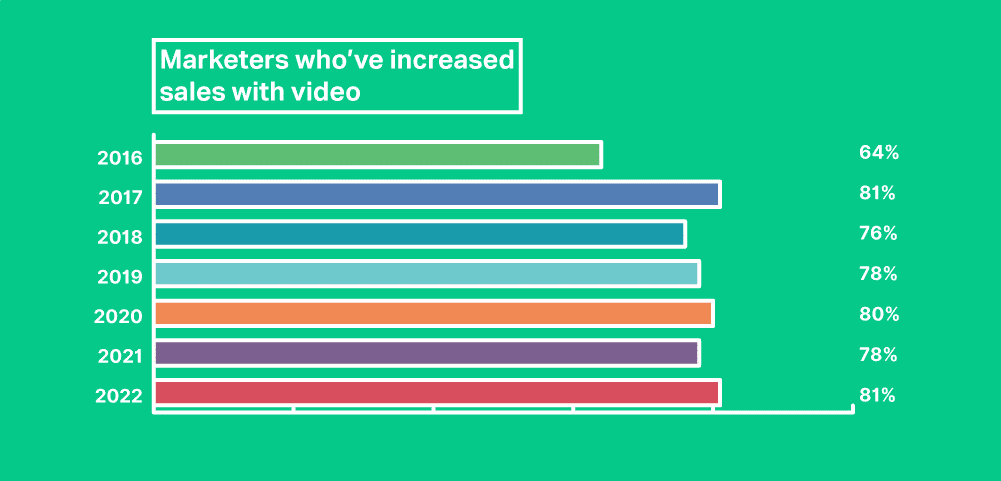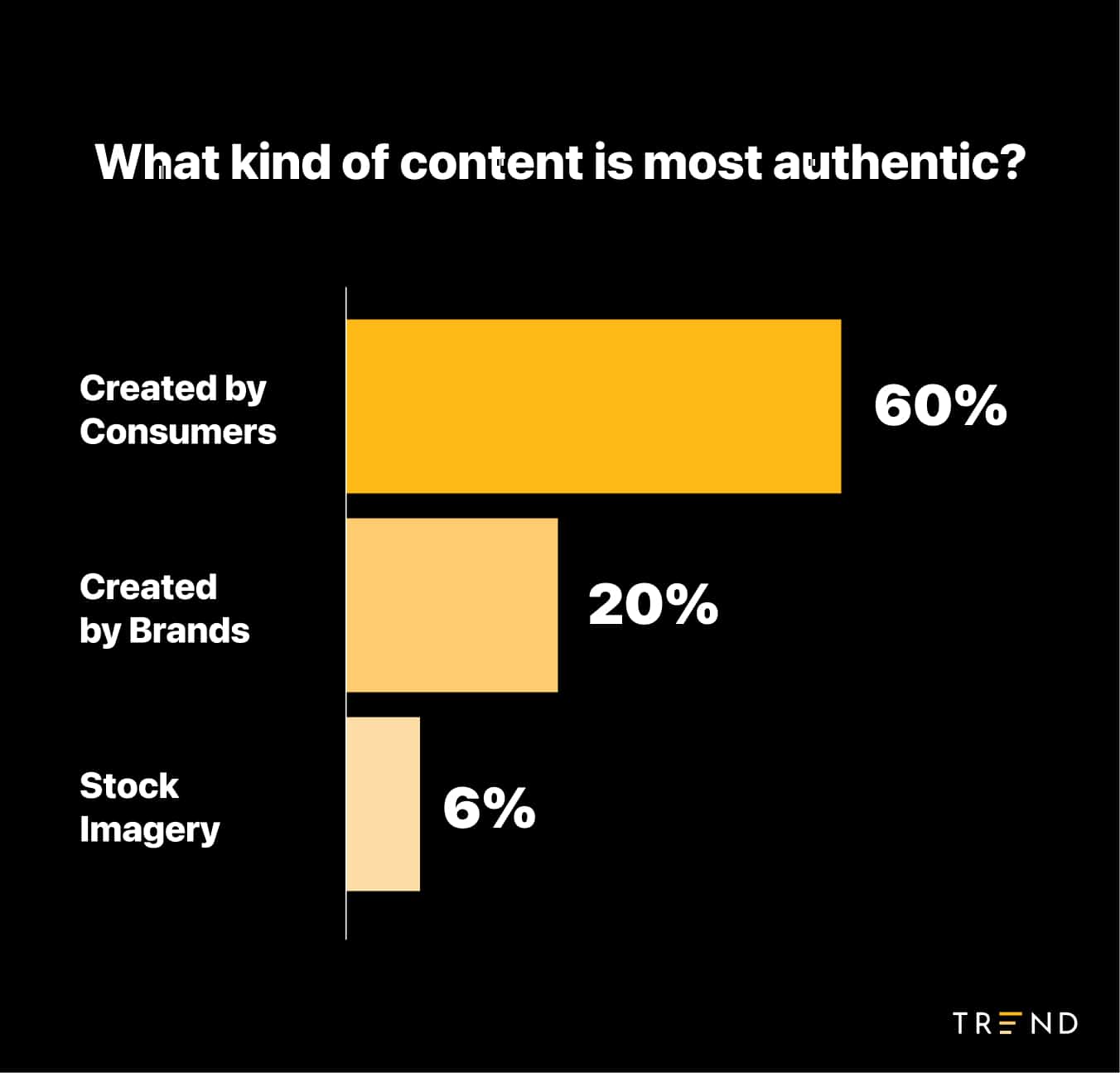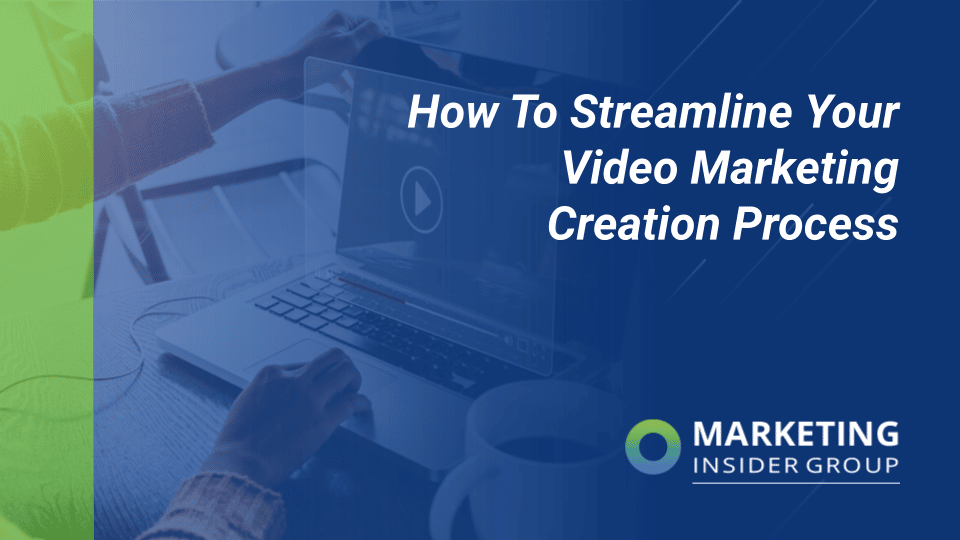
Video marketing trends have evolved into one of the most important aspects to consider for your content marketing strategy. Whether it’s a 30-second ad, vlog or live footage, featured videos in your content is one of the most popular and effective ways to engage your audience.
In fact, video is preferred by 80% of people over written text and is already being used by 87% of businesses as a marketing tool. If that’s not enough to convince you, research also shows that 88% of consumers have been convinced by a marketing video to purchase products and services.

Image Source: Wyzowl
Quick Takeaways
- Live video has become a critical part of connecting brands with consumers
- Vlogs and social media stories are great ways to show brand personality, educate your audience and create a personal connection with your community
- Most people watch videos without sound, making silent videos increasingly more popular
- User-generated content is rated as the most authentic, trustworthy form of online content
In 2023, video content is going to be critical for reaching your audience. Use these 8 video marketing trends to drive both traffic and revenue.
8 Video Marketing Trends for 2023
If a picture is worth a thousand words, just imagine what video content can do for your business. Here’s 8 video marketing trends you need to know to maximize your revenue in 2023.
Live Video
Live video skyrocketed in importance in 2020 as the pandemic put a halt on in-person events and experiences. It emerged as an essential way for startups and larger brands to continue connecting with consumers, and today our outlook on what kind of content is “streamable” has been totally transformed.
Live video is being used by everyone from influencers promoting products to music artists holding virtual concerts to Broadway companies streaming full-length productions.
For content marketers, live video should be at the top of the list of video marketing trends to follow in 2023. Even as life is getting back to normal, consumer demand for live video content isn’t going away — it’s growing.
And while consumers prefer video content in general, they engage at a much higher rate when the content is live. On Facebook, for example, users watch live videos for 3x longer than pre-recorded videos, and live content generates 6x more interactions.
Surprisingly, though, only 28% of video marketers intend to use Facebook Live as part of their strategy (and this stat is similar across social media platforms). More B2B Marketers are reporting the use of video email marketing as an effective tool.
The takeaway? Brands have an opportunity to build engagement and gain a competitive advantage by embracing live video right now.
Smartphone Production
Gone are the days when video marketing required expensive equipment and a big production budget. In fact, even brands that can afford those things are turning to smartphones to create more relatable, authentic content.
Apple gave the concept a platform in their wildly successful #ShotOniPhone campaign. They asked users to submit their best iPhone shots for a chance to have them featured on an Apple commercial or billboard.
Over the years the campaign has generated more than 15 million submissions and proven that video content created on a smartphone can be indistinguishable from what we see in traditional media.
In an interesting turn of events, social media influencers have surpassed even seasoned video marketing professionals when it comes to perfecting the art of smartphone video content.
Perfectly edited TikToks, vlogs, sponsored ads, you name it — it’s the amateurs who are doing it best right now when it comes to smartphone video.
Brands are getting on board, though, as they quickly realize that this type of real-life content is resonating with consumers more than salesy ads.
So if you’ve been thinking about creating more video content but worrying you might not have the equipment, here’s your sign: all you need is a little inspiration and the device in your hand.
Search-Optimized Videos
SEO is nothing new, but what about videos optimized for search? Forrester recently found that videos are 53 times more likely to generate first-page rankings than other traditional SEO techniques. Brightedge reports that Google is now putting video snippets next to 26% of search results, and users are more likely to click them when they do.
So how can you use videos to optimize your search engine results? Focus on three areas: relevance, consistency, and backend optimization.
First, be sure your videos all have a clear goal in mind. Make them relevant to consumers by answering their questions, educating them on important topics related to your brand, and creating video content that’s interesting to watch.
Next, be consistent. Just like with traditional SEO content, consistency is key to boosting your rankings. Create video content frequently and always publish it to your website where it will help boost traffic.
Finally, don’t forget important technical optimization steps like title tags, keywords in descriptions, choosing appropriate thumbnail images, and responding to comments to drive engagement.
Vlogs
We know that brand storytelling is one of the most effective ways to connect with consumers, develop your brand personality, and get your audiences engaged. Vlogs (or video blogs) are a great vehicle for telling those stories.
They’re also a great opportunity for sharing tutorials or product information, which makes viewers more likely to engage and convert. In fact, 94% of respondents say that watching a brand video has helped them make a purchase decision. Vlogging is an effective, cost-efficient way to educate your audience about products and services.

Image Source: Lemonlight
Vlogs position the creator or brand as the main character, telling the story of topics, events, and experiences from their perspective and helping consumers get a better understanding of who they are.
Vlogs are another tactic that influencers have already perfected — you can find vlogs on just about any topic from parenting to sports to pet care to travel (you name it). They’ve upped the ante for traditional bloggers in a world where even great text-only narratives aren’t enough to keep audiences coming back for more.
But research also shows that the overwhelming majority of vlog content is published by individual creators, meaning it’s time for brands to get on board with this video marketing trend. Vlogs are a great opportunity to create a human connection between your team members and your audience, showcase your brand personality, and keep consumers coming back for more of your content.
Social Media Stories
Like vlogs, social media stories show a brand’s personality and create a more personal connection than other content marketing trends. But social media stories aren’t exactly the same.
Mainly, they’re meant to be more casual. If vlogs are an edited version of your brand’s overarching tale, social media stories are the day to day outtakes that don’t belong in the final version (but that everyone still wants to see).
Social media stories also offer tons of ways to get interactive with your consumers. Use the questions feature on Instagram to do Q&A with your audience. Post polls to get their input on products and ideas.
Ask customers to tag you in their own stories so you can share the ways they’re wearing or using your products. These are just a few examples!

Image Source: AestheticHLO
Check out these brands who are already doing social media stories really well.
AR/VR Videos
AR and VR content has been around for awhile, but it’s finally finding its way into mainstream video marketing trends as technology becomes more accessible and consumers demand increasingly interactive content. Looking to the future, brands need to be ready to incorporate it into their video marketing strategies as traditional video may not always be enough.
The pandemic has accelerated the growth of AR and VR as brands across industries used it to create virtual experiences. Retail stores offered virtual “try before you buy,” healthcare providers used AR and VR for self-guided diagnostics, and educators kept students engaged with AR- and VR-powered games and activities.
Just like with live video, our view on what kinds of experiences can be virtual has transformed over the past year and a half, and consumers will be unlikely to want to give up the convenience and accessibility these virtual options provide. AR and VR may never totally replace the in-person experience, but they’re definitely here to stay as a key tactic for video marketers.
Silent Videos
Marketers today are creating videos specifically to be watched silently. Sounds crazy, right? Isn’t the whole point of a video to have image and sound? Not anymore.
A whopping 85% of videos on Facebook are watched without sound. In fact, 80% of consumers report that they have a negative reaction when an ad plays a loud sound unexpectedly. People are watching videos on their smartphones everywhere they go — in crowded waiting rooms, on public transportation, in classrooms, and even in meetings (let’s be honest).
This means that if you want people to stick around and watch your content, you need to optimize it for silent viewing. The good news is that most of the time, all it takes is the addition of closed captions to keep people engaged. People watch captioned ads for 12% longer on average than videos without captions. A quick fix!
User-Generated Content
Consumers overwhelmingly trust user-generated content more than branded content. In fact, 60% of consumers think UGC is more authentic and trustworthy than brand content.

Image Source: Trend
Rather than fight against the trend, you can partner with satisfied customers to have them act as brand advocates. Customers can generate video content on their own social channels and you can reshare it to give it more visibility.
Over time, this user-generated content builds consumer trust and influences purchase decisions. And finding brand advocates can be easy with the right approach! Offering incentives, working with influencers, creating referral programs, and simply asking are all ways to get satisfied customers on board with sharing stories and videos about their positive experiences with your brand.
Support Your Video Strategy Today With Compelling Content
A strong marketing strategy for 2023 needs great video content — but video isn’t enough to see sustained success. Brands also need a marketing strategy with consistent, compelling written content to drive results.
Marketing Insider Group has experienced writers and marketing professionals who can help you build a strategy and deliver optimized, ready-to-publish content every single week.
Get started today and check out our Content Builder Services or schedule a free consultation now!
The post 8 Video Marketing Trends You Need To Know for 2023 appeared first on Marketing Insider Group.


